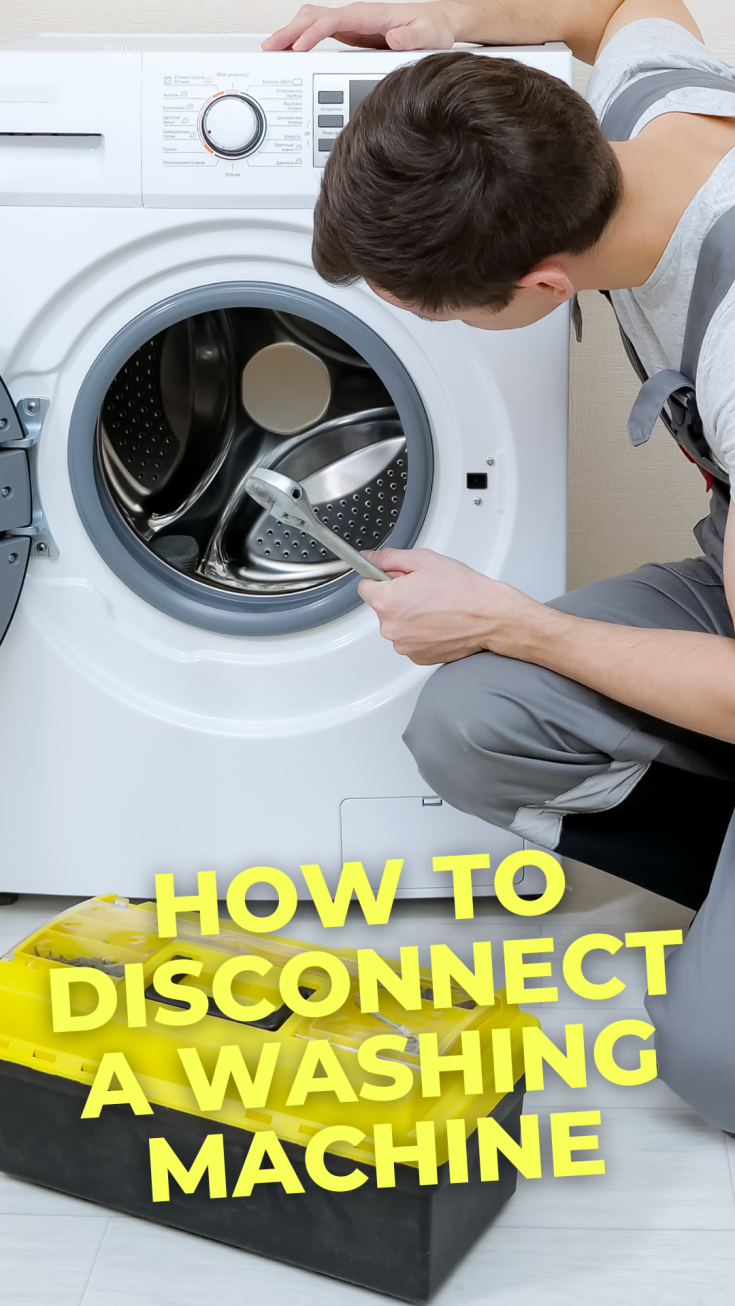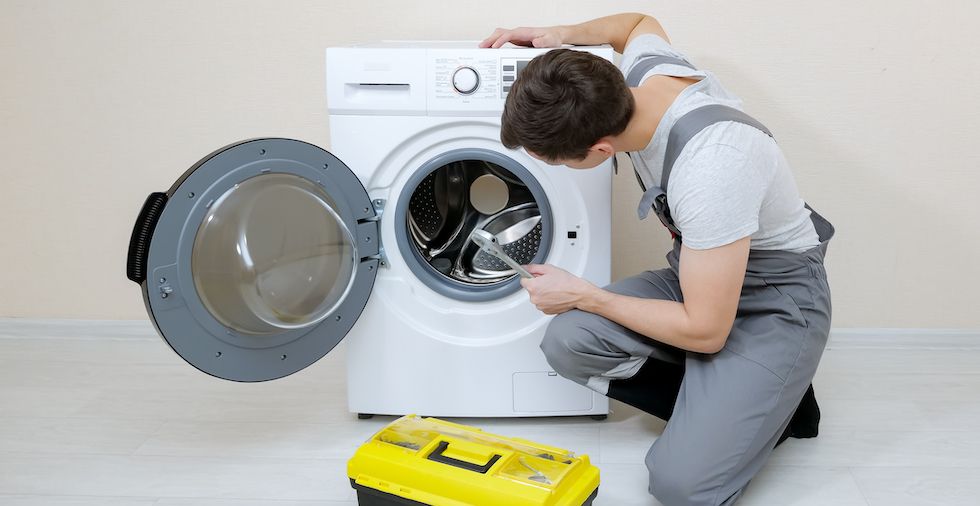Whether you're off to pastures new and want to make moving house a breeze or you're sprucing up your laundry corner with the latest appliances, disconnecting a washing machine might raise an eyebrow or two. But have no fear — it's easier than you might imagine.
Think of this guide as your trusty sidekick, here to unravel the mysteries of washing machine disconnection. In the following step-by-step guide, we'll navigate through the intricacies of plumbing, hoses, and the art of under-sink manoeuvres. Read on to learn each step of the process, along with some insider tips to simplify things.
The tools you'll need
To kick off this process, gathering all the tools and items you'll need is essential. Before disconnecting your washing machine, take a moment to ensure that you have everything on hand to make the process smooth and hassle-free. Not sure where to start? Here's a quick checklist of what you'll need:
- An adjustable wrench: This versatile tool will come in handy for various tasks during the washing machine disconnection process.
- Pliers: Having pliers ready will help you easily manipulate and loosen connections. Make sure that you have a decent pair to rely on here.
- Towels or rags: When you learn how to connect your washing machine, you will see that it may be messy. Keep these nearby to wipe up any spills or drips during the disconnection.
- A bucket or container: While we're on the subject of keeping things clean, here's another must-have. Having a receptacle to catch water prevents any mess.
- Plumber's tape: This tape helps seal and secure connections to prevent leaks in the future. You can pick it up at most DIY shops or online.
- An empty container for water: Finally, you'll need a container to capture any water remaining in hoses or pipes. Don't forget this vital component.
Assemble these essential tools in your workspace, ensuring you're fully equipped before you begin the washing machine disconnection process.
How to disconnect a washing machine
1. Turn off the power and water supply
Safety first! It's crucial to start by unplugging the washing machine from the electrical outlet to ensure there's no power running through it. This step protects you from any potential electrical hazards as you work on disconnecting the machine.
Additionally, locate the water supply valves, usually situated behind or beneath the machine, and turn off both the hot and cold water valves. Turning off the water supply prevents potential leaks or water damage while working on the disconnection.
2. Clear the area
Creating a clear workspace around the washing machine is not just about convenience, but also safety. Ensuring the area is clutter-free gives you ample room to manoeuvre and perform each step without any hindrance.
This step minimises the risk of tripping over objects or causing accidental damage to nearby items. Make sure that you do it before you get started on the main job.
3. Disconnect the water hoses
The water hoses are a vital part of the washing machine's functionality, and disconnecting them correctly is crucial to prevent water spillage. Now, if you are wondering how to disconnect a Beko washing machine, these steps apply to you, too.
Using your pliers or adjustable wrench, gently loosen the nuts that secure the water hoses to the back of the machine. Water may still be trapped in the hoses, so keep a bucket or container handy to catch any spills. By carefully detaching the hoses, you take preventive measures to avoid water damage and potential slips on wet surfaces.
Of course, several potential reasons might be causing your washing machine to hold onto its watery cargo. It's possible that the hose is clogged or the pump is out of commission. A faulty lid switch or a broken belt could also play a role. Occasionally, it could be as straightforward as a tangled hose causing the hiccup. Whatever the root cause, the water must be drained from the washing machine before we can get to the bottom of the issue.
4. Remove the drain hose
Next up, you need to remove the drain hose. The drain hose is crucial in removing water from the washing machine. As you detach the drain hose from the drainage pipe or sink connection, it's essential to have a towel or rag ready to handle any residual water that may flow out. This precautionary step prevents any unexpected mess and ensures a smooth disconnection process.
5. Tackle the waste pipe
The waste pipe is responsible for carrying out wastewater from the machine. Disconnecting it using your pliers or wrench and placing a bucket or container underneath, as you would if you were removing a radiator, is vital to catch any remaining water. Properly addressing the waste pipe ensures that you're preventing any potential leaks and maintaining the cleanliness of your workspace.
6. Address the electrical wiring (if applicable)
For integrated washing machines, there might be electrical wiring connecting the machine to the power source. If you're uncomfortable dealing with electrical connections, it's best to seek professional assistance. However, if you're confident in your skills, carefully disconnect the wiring according to the manufacturer's instructions. This step is essential for your safety and the integrity of the machine's electrical system.
7. Double-check everything
Before you conclude the disconnection process, conducting a thorough double-check is vital. Ensure that all the connections are properly disconnected and that there's no lingering water or moisture. This step guarantees you've completed the disconnection correctly and lowers the risk of future complications.
8. Revisit the water supply valves
Last but not least, the water supply valves. If you're heading off or if other appliances share the same water source, open those valves again. It's not just about convenience; it's like giving your home a reliable water source for its next performance.
And there you have it – a step-by-step guide to the art of washing machine disconnection. Armed with this newfound knowledge, you'll hopefully tackle disconnection like a seasoned pro. So take a bow – you've mastered the steps to a successful washing machine disconnection. But, do you know how to do laundry? We've got some new laundry tips that you won't want to miss, including things you didn't know you could clean in the machine.
Navigating disconnecting your washing machine isn't just about handling hoses – it's about orchestrating a transition. If any step feels uncertain, seeking professional assistance ensures a secure process and preserves the condition of your equipment. Don't forget, you can always hand wash your clothes in the meantime if anything goes wrong.
You might find that you don't need a replacement machine - it just needs sprucing up! Read our article on how to clean your mouldy washing machine next.
Q&A
Did we miss something along the way? If you have more questions, you've come to the right place. Take a look at some of our frequently asked questions below:
Does the washing machine run off the mains?
Yes. The washing machine tends to be connected to the main water system of your home. Plumbers often attach washing machines to the main pipe that feeds into your kitchen tap. Should that be the case, you will find it is attached directly to the main water supply. If you have further questions, it may be worth speaking to a plumber.
Do you need a drain pipe for a washing machine?
If you have a new washing machine, you may find that the cycles use a lot of water. For that reason, you will need a drain pipe that can handle the volume of water that the machine uses. Learn about the common washing machine drain errors here.
Why is my washing machine flooding when draining?
If your washing machine is flooding when draining water, the reason may be that the drain pipe is clogged. While you can try unclogging your drain pipe, if the problem continues, you may want to call a plumber to help.
Can a washing machine flood your house?
Yes! If your washing machine is not installed correctly or fails to drain, it can lead to a flood. The water from a washing machine can lead to excessive amounts of damage. For that reason, you need to make sure that your washing machine has a proper way to drain and that it is installed the right way.
Do you have any more questions? Leave us a comment below!


Leave a Reply